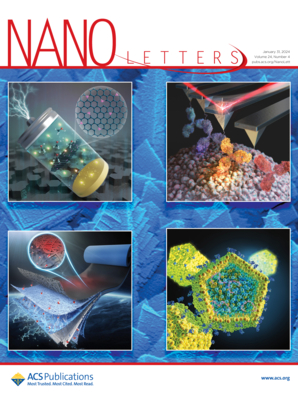Influence of Metal Interlayers on Spin-Charge Conversion in Sb2Te3 Topological Insulator-Based Devices
IF 9.6
1区 材料科学
Q1 CHEMISTRY, MULTIDISCIPLINARY
引用次数: 0
Abstract
The magnetization of a ferromagnetic layer can be controlled via spin-charge conversion (SCC) phenomena originating in an adjacent topological insulator (TI). Insertion of nonmagnetic interlayers between these materials has been demonstrated to enhance the SCC efficiency, as shown for Sb2Te3/Au/Co(Fe) heterostructures. The inert nature of the Sb2Te3/Au interface was assumed to preserve the topological surface state (TSS) of Sb2Te3, which mediates the SCC. Al is explored as an alternative to Au for its long spin diffusion length. Spin pumping experiments indicate the absence of SCC in the Sb2Te3/Al/Co heterostructure. Core level and valence band photoemission spectroscopies reveal that Al forms stable compounds with Te and Sb, thereby quenching the TSS of Sb2Te3, while the TSS is preserved upon the formation of the TI/Au interface. These results demonstrate directly the major influence of material chemistry and highlight the role of TSS on the SCC efficiency in TI-based devices.

金属夹层对基于 Sb2Te3 拓扑绝缘体器件中自旋电荷转换的影响
铁磁层的磁化可以通过邻近拓扑绝缘体(TI)产生的自旋电荷转换(SCC)现象来控制。对于Sb2Te3/Au/Co(Fe)异质结构,在这些材料之间插入非磁性中间层已被证明可以提高SCC效率。假设Sb2Te3/Au界面的惰性性质可以保持Sb2Te3的拓扑表面态(TSS),从而介导SCC。Al因其较长的自旋扩散长度而被探索作为Au的替代品。自旋抽运实验表明Sb2Te3/Al/Co异质结构中不存在SCC。核能级和价带光发射光谱显示,Al与Te和Sb形成稳定的化合物,从而使Sb2Te3的TSS猝灭,而TSS在TI/Au界面形成后被保留。这些结果直接证明了材料化学的主要影响,并突出了TSS对ti基器件中SCC效率的作用。
本文章由计算机程序翻译,如有差异,请以英文原文为准。
求助全文
约1分钟内获得全文
求助全文
来源期刊

Nano Letters
工程技术-材料科学:综合
CiteScore
16.80
自引率
2.80%
发文量
1182
审稿时长
1.4 months
期刊介绍:
Nano Letters serves as a dynamic platform for promptly disseminating original results in fundamental, applied, and emerging research across all facets of nanoscience and nanotechnology. A pivotal criterion for inclusion within Nano Letters is the convergence of at least two different areas or disciplines, ensuring a rich interdisciplinary scope. The journal is dedicated to fostering exploration in diverse areas, including:
- Experimental and theoretical findings on physical, chemical, and biological phenomena at the nanoscale
- Synthesis, characterization, and processing of organic, inorganic, polymer, and hybrid nanomaterials through physical, chemical, and biological methodologies
- Modeling and simulation of synthetic, assembly, and interaction processes
- Realization of integrated nanostructures and nano-engineered devices exhibiting advanced performance
- Applications of nanoscale materials in living and environmental systems
Nano Letters is committed to advancing and showcasing groundbreaking research that intersects various domains, fostering innovation and collaboration in the ever-evolving field of nanoscience and nanotechnology.
 求助内容:
求助内容: 应助结果提醒方式:
应助结果提醒方式:


